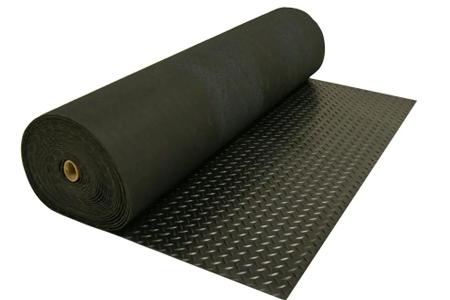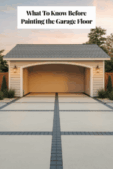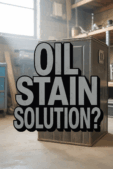Is Rubber Roll-Out Flooring Your Best Bet for the Garage?

If you’re looking for a garage flooring option that is durable, safe, and incredibly easy to maintain, then rubber rolls should be at the top of your list. This resilient flooring is a fantastic upgrade for any garage space.
Made from tough natural or synthetic rubber, these rolls are built to withstand heavy vehicle traffic and provide a secure, slip-resistant surface. They are also famously easy to clean and demand very little maintenance over their long lifespan.
Rubber flooring rolls offer excellent durability, standing up to the harsh conditions of a busy garage. They also provide a superior level of safety with a slip-resistant surface, which is crucial when floors get wet from rain or snowmelt.
While the installation process is straightforward, some essential prep work ensures the best results. Once installed, you’ll find that cleaning and maintaining your new floor is remarkably simple.
Beyond its practical benefits, rubber flooring is available in a wide variety of colors and styles to match your garage’s look. It’s also an eco-friendly choice, often made from recycled materials, giving you great long-term value for a reasonable cost.
How Durable Is Rubber Roll Flooring?

Rubber garage floors are specifically designed to endure heavy traffic, hot tires, and the inevitable dropped tool, ensuring they last for many years. With the right care, you can expect your rubber flooring to last a decade or even longer.
However, be aware that extreme weather conditions might affect the flooring’s longevity. It’s critical to choose roll-out rubber flooring specifically made for garages, as these are designed to resist chemicals and dramatic temperature fluctuations.
Rubber flooring comes in two main types: natural and synthetic. Natural rubber is derived from rubber trees, while synthetic rubber is a petroleum product. According to FlooringInc, both are durable, but high-quality synthetic rubber is more common for automotive use due to its enhanced resilience.
For even more strength, look for vulcanized rubber. This is a type of synthetic rubber treated with heat or chemicals, dramatically improving its strength and resistance to weathering. This process makes it a top choice for commercial applications and busy garages.
It is perfectly fine to install rubber garage flooring in extremely cold climates. The key is ensuring the flooring is installed correctly per the manufacturer’s guidelines, which prevents it from curling or cracking under the stress of the cold.
Stay Safe: The Slip-Resistant Benefits of Rubber Flooring

One of the most compelling reasons to choose rubber is its naturally slip-resistant quality. This feature provides an essential layer of safety in a space where spills are common.
In fact, its grip often improves when wet. This makes it an ideal safety measure for garage floors where rain, snowmelt, or spills can create serious hazards.
The surface of rubber flooring contains countless tiny pores that act like grippers on the soles of your shoes. This microscopic texture helps prevent slips and falls, keeping you and your family safe.
Whether you’re working on your car or just walking through the garage, this added traction provides valuable peace of mind.
Installation Insights: What to Know Before You Roll It Out

Installing rubber garage flooring rolls is a relatively easy process that many homeowners can tackle themselves. The first step is to thoroughly clean and prepare the concrete subfloor, removing any oil, grease, or other contaminants for proper adhesion.
Next, measure the area to be covered and carefully cut the rolls to size. A sharp utility knife or heavy-duty scissors works well for this; use a cutting mat to protect the floor underneath.
Depending on the product, you may apply double-sided tape or a recommended adhesive to the back of the roll. Once the adhesive is applied, place the roll in the desired location and use a roller or other weighted object to press it firmly into place and smooth out any bubbles.
It’s important to be aware that non-breathable roll-out mats can trap moisture underneath. This can potentially lead to mildew or odors if your garage has humidity issues, so ensure your concrete is sealed or the space is well-ventilated.
While this is a DIY-friendly option, consider a professional installation for a flawless finish. Experts can ensure the subfloor is perfectly prepped and the seams are tight, maximizing the life and look of your new floor.
How Do You Keep Rubber Garage Floors Clean?

Rubber garage floors are incredibly easy to clean and maintain, saving you time and effort. For routine cleaning, you can simply sweep or vacuum the floor to remove loose dirt and debris.
If the floor is wet or has light soiling, you can use a mop or a damp cloth to wipe it down. For a more thorough cleaning, you can even use a hose to rinse the entire floor down.
To remove stubborn stains, use a mild detergent or a cleaner specifically designed for rubber floors. It’s important to avoid using harsh chemicals or abrasive cleaners, as these can easily damage the surface of the floor.
Don’t panic about engine oil spills, as they will not immediately ruin a high-quality garage rubber floor. In fact, rubber flooring is prized in auto shops for its resilience against chemicals.
However, you should always clean up any oil or chemical spills as soon as you notice them. If left for an extended period, they could eventually stain or degrade the flooring’s surface.
What Styles and Colors Are Available?

Modern rubber flooring offers a surprising range of style choices that go far beyond basic black. You can find options in colors like tan and gray to match your tools, cabinets, or personal style.
The rolls also come in different patterns, including classic solids and dynamic checkerboard designs. This allows you to create a custom look that turns your garage from a purely functional area into a stylish one.
You can also choose from various textures, including smooth, pebble, diamond, and ribbed. Smooth rubber is the easiest to clean, making it a very practical choice.
Pebble and diamond textures add extra traction while still being relatively easy to clean. Ribbed rubber provides the most slip resistance but can be more challenging to sweep clean due to its deep grooves.
Is Rubber Flooring an Eco-Friendly Choice?

For those looking to make more eco-friendly choices, installing rubber garage flooring is a great step.
A significant portion of the rubber flooring on the market is made from recycled tires. This makes it a sustainable material that actively diverts waste from landfills.
Its durability and long-lasting nature also contribute to its green credentials. Because you won’t have to replace it as often as other types of flooring, you consume fewer resources over time.
In addition, rubber is easy to clean with simple, non-toxic methods. You can keep your garage looking its best without resorting to harsh chemicals that are bad for the environment.
How Much Does Rubber Roll Flooring Cost?

While rubber roll flooring isn’t the cheapest option upfront, it represents a fantastic long-term value. The initial cost typically falls between $2 and $4 per square foot for the rolls themselves.
This can seem higher than simple concrete sealers or some epoxy paint kits. However, as flooring experts note, its incredible durability and low maintenance costs make it a more economical choice over its lifespan.
For a standard one-car garage, you will need at least 24 linear feet of rubber flooring to cover a 12×12 foot area. You may need more depending on the size and shape of your garage.
If you choose to have it professionally installed, expect to pay between $2 and $4 per square foot for labor, in addition to the material cost.
If the total cost is a concern, you can always start with smaller garage mats to protect key areas. For more on that, read our article: Garage Floor Mat Materials: Choosing the Best Mat Material for Your Needs.
Is Rubber Roll Flooring Right for Your Garage?

When you begin your search, you’ll encounter a few major brands of rubber roll garage flooring. Two of the most reputable include Diamond Plate by Rubber-Cal and G-Floor by Better Life Technology.
Rubber roll garage flooring is an outstanding choice for anyone seeking a solution that is durable, safe, and requires very little maintenance. The benefits far outweigh the initial investment.
While the upfront cost may be higher than some paint-on alternatives, its longevity and resilience make it a sound financial decision for the long run. Proper installation is key to avoiding moisture issues, so plan accordingly.
No matter which style or texture you choose, rubber garage flooring is an excellent way to upgrade your garage. You can turn a purely functional space into one that is cleaner, safer, and far more impressive.









